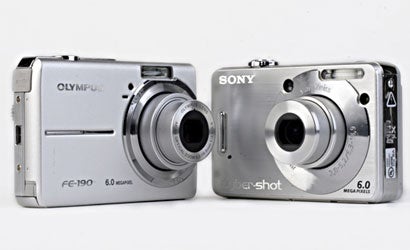Econocam Shootout!
See how the Olympus FE-190 fares against the Sony Cybershot DSC-W50 in this battle of 6-megapixel, 3x digicams.

We may earn revenue from the products available on this page and participate in affiliate programs. Learn more ›
Major brands are now offering 6-megapixel, 3x zoom digital cameras in the $200 range, so we thought we’d size up two of the leading contenders: the just-introduced Olympus FE-190 (street: $180) and the hot-selling Sony Cybershot DSC-W50 (street: $230).
On the surface these cameras are virtually identical, with nearly the exact physical dimensions. Both have right offset 3x flush-folding 6.3-18.9mm zooms (35mm equiv: 38-144mm). Both have 2.5 inch LCDs next to multi-controllers and a mode dial on the back. The Sony does manage to incorporate a tiny optical viewfinder, unlike the Olympus.
Bucking the trend towards SD card homogeny, the Sony Cybershot DSC-W50 sticks with the Memory Stick Duo format that Sony favors for its compact digicams, while the Olympus FE-190 keeps with its company’s standard media type for compacts, storing images in xD format.
Both cameras are marketed towards first-time and budget-buyers, with an emphasis on ease of use at an affordable price.
These cameras, especially the Olympus, truly are Point and Shooters in the truest definition of the term. The Olympus FE-190 is almost totally auto-everything — auto white balance, auto ISO selection, and auto exposure! There are very few user-selectable options, outside of Scene modes and exposure compensation.
There is such a minimum of user-controllable functions with the Olympus FE-190 that we could not control the camera enough to produce a full lab report within our normal testing protocols.
So, instead, we went out exploring some of Manhattan’s landmarks on a less-than-perfect afternoon, and set both the Olympus FE-190 and Sony CyberShot DSC-W50 to autopilot for our head-to-head battle of the econocams.
Let’s cut right to the chase: The Sony outperforms the Olympus in most categories, but the Olympus does have a certain charm, and may find a niche in the crowded digicam marketplace.
We’re going to compare several aspects of each camera and also present an image quality photo gallery of identical photographs shot with each camera, including several “actual pixels” comparisons, to help you come to an informed, budget-minded decision.
We’ll start with one category where the Olympus FE-190 is far and away superior: Overall camera construction. The buttons on the FE-190 feel solid, without being either too stiff or too loose. The lens retracts and zooms smoothly, and it feels very good in the hand.
The Sony Cybershot DSC-W50 feels cheaply made, as if quality control is not important in an entry-level camera. There is a lot of play in the cheap-feeling zoom toggle which is wrapped around the shutter button, and the rear multi-controller is ridiculously stiff. The lens retracts and zooms OK, but the retractable lens cover did stick halfway open on a couple of occasions. Sony has a slight edge on the Olympus in the battery/memory card cover, but not by much. Both feel like they might snap off if you sneeze at them. And both cameras have cheap plastic tripod mounts. Be careful about over-tightening!
Overall, the Olympus feels better built than the Sony, except for the 2.5 inch LCD. Sony rules here. There’s a hard protective layer above the Sony’s LCD, while the Olympus LCD can be pushed and smushed with a slight touch.
Both are slower than more pricey cameras with image processing, with the Sony having a little bit faster shot-to-shot time in shooting mode. In Playback mode, the Olympus is brutally slow, taking over a second between images, while the Sony zips along with almost no redrawing lag.
Burst mode? Sony’s barely got one, firing off three shots without flash in just under 2 seconds, while there is no burst mode of any sort on the Olympus.
Ease of use? Olympus gets the nod here. The FE-190 truly is point-and-shoot easy. Turn it on, and it’s ready to take your snapshots.
Degree of creative control? The Sony Cybershot DSC-W50 has more user-selectable options such as white balance and ISO speed.
Both cameras have a digital shake reduction solution — ISO boost is what Sony calls it, while Olympus calls it DIS (Digital Image Stabilization). We prefer optical or mechanical shake minimizing technologies, but that’s not to be found on either of these models. The Olympus also offers a Pixel Mapping function to test and correct for dead pixels.
Movie mode? Of course, that’s par for the course on compact digicams. Both record at 640×480 at 30fps with audio, but only the Olympus allows you to zoom while recording.
But bells and whistles (or lack thereof) are just a small part of the equation. The thing that matters most to us at PopPhoto.com is image quality.
And in almost every test shot, the Sony Cybershot DSC-W50 outperformed the Olympus FE-190. And when both cameras produced virtually the identical image in terms of exposure and color balance, the Sony showed sharper detail with less visible chromatic noise.
The decision between these two cameras for the budget-minded buyer is not an easy one. The Sony Cybershot DSC-W50 feels cheapish, and it is $50 more than its competitor, but it makes better photos under most conditions.
The Olympus FE-190, on the other hand, is ridiculously easy to use, is quite solidly built and inexpensive for its megapixel class, and the photos it makes will be OK (but not great) in small print and on-screen formats.
Our advice: If you absolutely cannot spend more than $200 for a digicam, get the Olympus FE-190. It is OK for small prints and email sharing, and it will most probably outperform and outlast any cheaper off-brand 6-megapixel camera from a brand you’ve never heard of.
But if you can up your budget just a bit, spend the extra $50 and buy the Sony Cybershot DSC-W50. It is a worthwhile upgrade in image quality, for not a whole lot more.
Sony Cybershot DSC-W50
Street: $230
Dimensions: 2.3 x 3.5 x 0.9″
Weight: Approx 5 oz with battery, card
LCD: 2.5″ TFT color LCD (115,000 pixels)
Lens: 3x optical zoom. 6.3mm – 18.9mm (38mm – 114mm equivalent) 3x
Battery Life: 390 shots (CIPA estimate)
Scene Modes: Twilight, Twilight Portrait, Soft Snap, Landscape, Beach, Snow, High Sensitivity
Media Type: Memory Stick DUO/Memory Stick DUO PRO
In the Box: Camera, NP-BG1 Rechargeable Lithium-Ion Battery Pack (3.6v, 960mAh), BC-CSG Battery Charger, AV/USB Multi-Connector Cable, Wrist Strap, Software CD-ROM (Cyber-shot Viewer 1.0, USB Driver), User Guide, 1-Year Sony U.S.A. Limited Warranty
Olympus FE-190
Street: $180
Dimensions: 2.3 x 3.6 x 0.7″
Weight: Approx 4.5 oz with battery and card
LCD: 2.5 inch Color LCD (110,000 pixels)
Lens: 3x optical zoom 6.3mm – 18.9mm (38mm – 114mm equivalent)
Battery Life: 190 shots (CIPA estimate)
Scene Modes: Auto, Scene Presets (Portrait, Landscape, Night & Portrait, Indoor, Candle, Self-Portrait, Sunset, Sport, Fireworks, Cuisine, Documents, Behind Glass, Auction), Digital Image Stabilization Mode, Movie
Media Type: xD card.
In the Box: Camera, LI-42B Lithium-Ion Rechargeable Battery, LI-40C Battery Charger, USB Cable, Audio/Video Cable, Wrist Strap ,Software CD-ROM (Olympus Master software), Advanced Manual CD-ROM, Quick Start Guide, Basic Manual, 1-Year U.S.A. Limited Warranty
Olympus FE-190
What’s Hot:
Simple to use.
Solid construction at a great price.
What’s not:
Brutally slow playback mode.
No “easy mode” manual overrides.
Cheap tripod mount and battery cover.
Sony CyberShot DSC-W50
What’s Hot: Optical viewfinder in budget camera.
Manual control of ISO, white balance.
What’s Not:
Cheap overall construction.
No zoom during movie recording.
Image Comparison Gallery
We wandered around Manhattan looking for interesting and challenging subjects to see how these econocams do in real-world shooting situations in full automatic mode.
In many cases, we were mostly pleased with the results with an eye towards 4×6 prints, especially at 1x and 2x, but both cameras disappointed us with camera blur when trying to grab a shot of Times Square’s “Naked Cowboy” at 3x under sunny afternoon lighting conditions.
We’ve also pulled out several blocks of full-resolution image detail for you to compare image quality.
No image adjustments, except for resizing for web publication, have been made to any images in these galleries.
See our image quality gallery for assessments of each pair of images assuming a print size of 4×6.

It-s-a-dead-heat-with-the-famous-Naked-Cowboy-of-T

Both-cameras-did-great-nailing-the-exposure-on-the

Taken-with-the-Olympus-FE-190.-A-typical-street-sc

Taken-with-the-Sony-Cybershot-DSC-W50.-The-Sony-ha

Taken-with-the-Olympus-FE-190.-Yes-this-is-a-busy

Sony-has-an-edge-in-this-image-for-overall-sharpne

Olympus-FE-190-It-s-a-dead-heat-with-the-famous-N

Taken-with-the-Sony-Cybershot-DSC-W50

Virtually-a-dead-heat-in-terms-of-color-temp-and-e

Taken-with-the-Olympus-FE-190

Taken-with-the-Sony-Cybershot-DSC-W50

Again-virtually-a-dead-heat-in-terms-of-exposure

Again-virtually-a-dead-heat-in-terms-of-exposure

Virtually-a-dead-heat-in-terms-of-color-temp-and-e